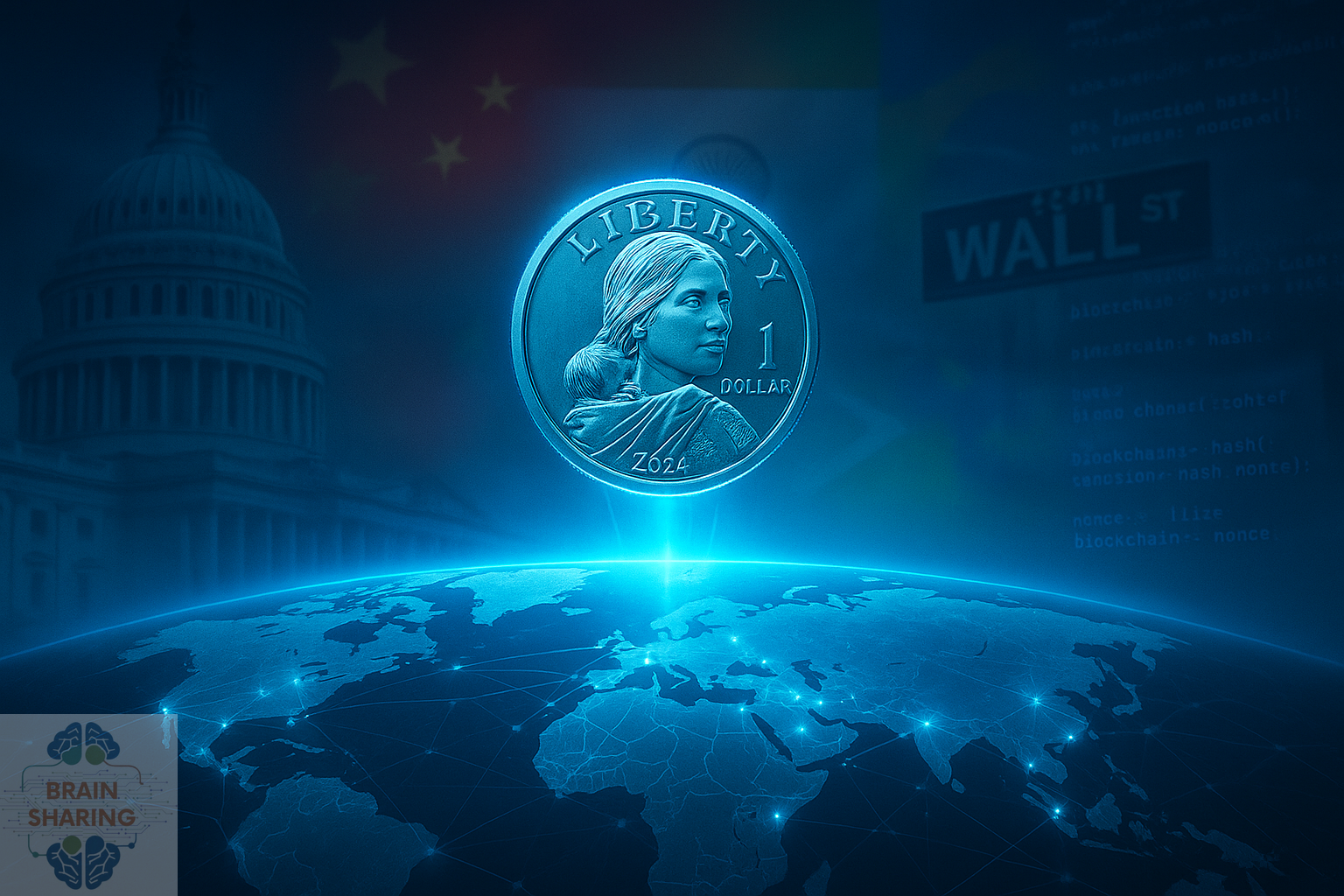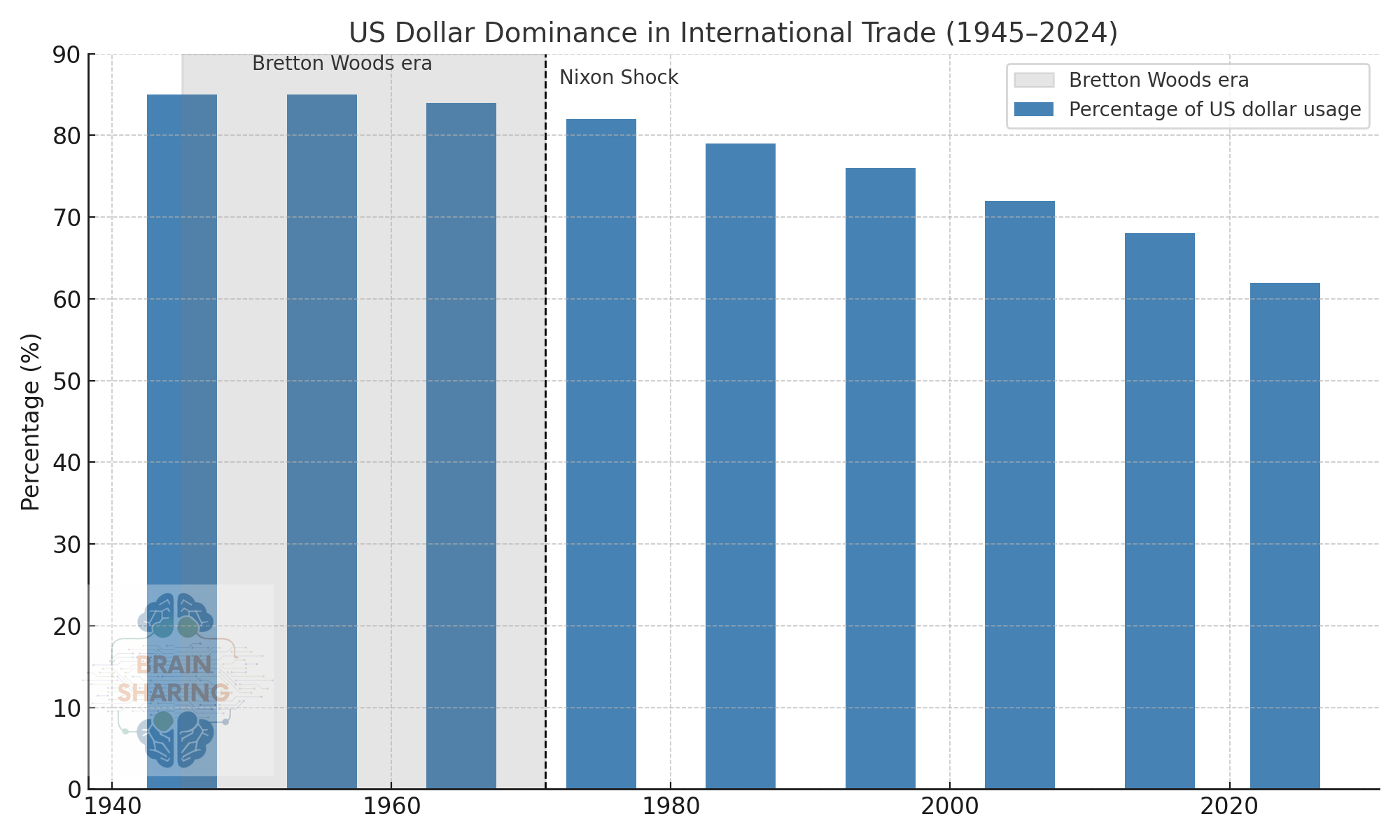
As global financial power shifts, stablecoins empower the U.S. to maintain dollar dominance.

Synopsis:
Stablecoins—digital tokens pegged to the U.S. dollar—are emerging as a critical force in preserving American economic dominance amidst rising global challenges. As BRICS countries push de-dollarization and rivals like China launch state-controlled digital currencies, the article explores how U.S. financial leadership is now shaped less by traditional exports and more by the country’s role in blockchain, AI, and next-generation digital assets.
The narrative traces the dollar’s historic and current strength, noting its underlying advantages for U.S. trade, borrowing, and geopolitical strategy. However, recent economic turbulence, growing debt, and shifting global alliances are putting that dominance at risk. The rise of stablecoins like USDT and USDC, which now power over $120 billion in daily transactions and are widely used in emerging markets, is helping keep the dollar relevant in the new digital era. With over $180 billion in U.S. Treasuries backing these currencies, stablecoins reinforce American influence on global liquidity.
The article contrasts America’s flexible, market-driven approach to digital assets with China’s state-directed digital yuan, highlighting why the fusion of government, finance, and crypto innovation is vital. It closes by warning that protecting the dollar’s central role is essential—not just for the U.S., but for the stability of the entire Western economic order.
As U.S. financial dominance faces threats from rising debt, inflation, and BRICS-led de-dollarization, stablecoins offer a powerful tool to protect America’s economic influence, empower innovation, and keep the dollar king in a digital world.
In a world where geopolitical alliances are shifting, economies are fragmenting, and digital finance is rising fast, the U.S. dollar is under siege — but stablecoins may be the key to defending it.
#Stablecoins #USDollar #DigitalAssets #CryptoPolicy #BitcoinReserve #DeDollarization #Web3Finance #BRICS #FintechInnovation #DigitalDollar
Continue and read the whole article below .
The content below was originally paywalled.
The Dollar: America’s Hidden Weapon
For decades, global economic power has rested not just on tanks or treaties, but on trust in a currency — the U.S. dollar. As the world’s reserve currency, nearly 90% of all international trade and financial transactions are priced in dollars. This dominance gives the United States unparalleled economic leverage, low borrowing costs,
and the power to impose sanctions, direct investment flows, and run large fiscal deficits with relative ease.
But that dominance is no longer guaranteed. And if the foundation begins to crack, the reverberations could be global.
BRICS and the Global Push to De-Dollarize
The BRICS coalition (Brazil, Russia, India, China, and South Africa) has amplified calls to reduce dependence on the U.S. dollar. In response to sanctions, political uncertainty, and concerns about unsustainable American debt, BRICS nations are building their own cross-border payment systems and exploring alternatives to dollar-based trade. China’s digital yuan, Russia’s crypto-ruble models, and the emerging “BRICS Pay” platform are all part of a broader strategy: to weaken the grip of the dollar on global commerce.
This shift could radically change how global markets operate—and experts warn that it could cost the U.S. its most powerful economic advantage.
America’s Financial Armor Is Wearing Thin
As of 2025, the U.S. faces sharp economic challenges. Rising interest rates, inflationary pressures, and spiraling national debt have all raised questions about long-term fiscal sustainability. Investors are diversifying away from U.S. Treasuries. Meanwhile, America’s political divides and past trade wars have undermined global confidence in the dollar’s neutrality. The result? A historic drop in dollar holdings by central banks and trading partners alike.
Under these conditions, defending the secure status of the dollar is not optional—it’s a national imperative.
Enter Stablecoins: Digital Dollars with Global Reach
Stablecoins—digital tokens typically pegged to the U.S. dollar or other stable assets—have exploded into the global financial system. Unlike cryptocurrencies like Bitcoin or Ethereum, stablecoins like USDT (Tether), USDC (USD Coin), Dai (MakerDAO), and PYUSD (PayPal USD) are now industry benchmarks for reliability, adoption, and liquidity. These players dominate the stablecoin landscape, anchoring trillions in annual transaction value across every continent.
They offer something traditional systems cannot: real-time global payments without costly intermediaries. By encouraging regulated, dollar-pegged stablecoins, the United States can digitize its most crucial asset and extend its influence into new digital territories.
Stablecoins help the U.S. in several tactical ways. They preserve global demand for the dollar by embedding it into rising crypto and fintech ecosystems. They empower faster, cheaper international payments, and help the U.S. compete with BRICS. Stablecoins also facilitate innovation and financial inclusion, reinforcing the U.S. position as a leader in future-ready economic infrastructure.

U.S. vs. State-Controlled Models: The Digital Yuan Challenge
The United States is blazing a different trail from authoritarian competitors. While China has unleashed the digital yuan—a fully state-controlled, centrally managed digital currency with built-in surveillance and government-imposed limits—the U.S. model is fundamentally different. America is betting on a market-driven, private-public hybrid: open, competitive, and decentralized, with privately issued stablecoins backed by regulatory guardrails and integrated with public financial institutions. This approach multiplies innovation, global trust, and user choice, in sharp contrast to Beijing’s top-down, programmable, and tightly surveilled system. The digital currency race is not just technical—it’s a battle of economic philosophies, and America’s hybrid, innovation-first ethos could give its digital assets a global edge.
The Modern Stablecoin Landscape: Key Facts and Figures
Daily Transaction Volume: The leading stablecoin, Tether (USDT), drives daily on-chain volumes exceeding $120 billion, while USDC averages more than $16 billion per day.
Emerging Market Usage: Emerging markets now account for a substantial—and rising—share of global stablecoin transactions, vital for cross-border payments and accessing dollar liquidity where local currencies falter.
Treasury Collateralization: As of mid-2025, stablecoin issuers collectively hold more than $180 billion in U.S. Treasuries as collateral, reinforcing the role of stablecoins in supporting U.S. government liquidity and global demand for dollars.
Risks in a Volatile Ecosystem
Stablecoins promise stability, but they’re not immune to shocks—and the past few years have been revealing. The infamous UST (Terra) collapse in 2022 erased tens of billions in value overnight, shattering confidence in algorithmic stablecoins and exposing the dangers of under-collateralization and poorly understood risks. This event made clear why transparency, robust collateralization, and frequent audits are non-negotiable.
Meanwhile, Tether (USDT)—the largest dollar-pegged stablecoin—has faced ongoing scrutiny from regulators and financial watchdogs over the transparency and safety of its reserves. Questions about whether every token is fully backed by liquid assets have sparked persistent concern, highlighting the critical need for robust and transparent regulation. Without it, systemic risk and a crisis in market trust could spread fast.
The Dollar’s Place in Global Trade: Still the Prize
Keeping the U.S. dollar at the heart of global trade is not just beneficial—it’s essential for American prosperity and stability. The transactional supremacy of the dollar enables the United States to absorb shocks, fund large-scale programs, and export both financial stability and influence worldwide. Recent data shows that around 88% of foreign exchange transactions and over half of international trade invoices still involve U.S. dollars, though the share is gradually eroding as new competitors and technologies emerge. If that dominance fades, the fallout for American borrowing costs, policy options, and global strategic clout would be immediate and profound. In this context, stablecoins have become a powerful way to project dollar supremacy, from Wall Street to Nairobi to São Paulo.

Is It Enough?
There’s momentum—bipartisan policymakers in Washington are crafting legislation. Housing stablecoins under smart, clear rules could amplify their benefits and minimize risks. Still, America risks ceding ground to more agile nations offering regulatory clarity and bold leadership.
Stablecoins are no longer fringe—they’re strategic infrastructure. With robust U.S. leadership, they can serve as the scaffolding for sustaining dollar supremacy in a digital age.
Final Thoughts
America’s economic future may soon be minted in smart contracts, moved on blockchain ledgers, and balanced on stablecoin rails. Stablecoins are fast becoming the dollar’s greatest digital disciples, reshaping the global financial system. If the U.S. adapts boldly, it could retain its long-standing foundation of leadership in a rapidly evolving world.
In our next article, we will examine how losing the dollar’s central place could reshape the U.S. and Western economies—underlining the urgency of defending the dollar’s lead. We’ll then dive deeper into why crypto and digital assets have become so crucial: exploring the idea that America’s new economic product is no longer just industry or software, but its unrivaled ecosystem of blockchain technology and advanced AI. This next wave may represent the true engine of twenty-first century U.S. influence in global markets.
